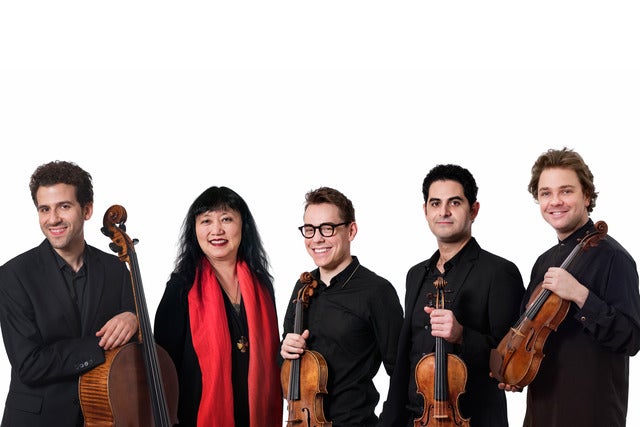The Chamber Music Society of Lincoln Center bills itself as “the nation’s premier repertory company for chamber music…committed to bringing audiences the finest performances of an extraordinary body of repertoire, dating as far back as the Renaissance and continuing through the centuries to the finest works of our time.” Indeed, to experience these musicians is a treat. Whatever the period or range of complexity, they bring unequaled expertise. This concert of contemporary music spanned the years 1940-2013; and, as any concert of this type, it brought challenges to the listener as well as the players. Congratulations to the Library of Congress for programming music of this century.
The entire second half of the evening was devoted to the great Oliver Messiaen and one of his best known works, “Quartet for the End of Time”(1940-41) for clarinet, violin, cello, and piano. This remarkable work was composed during the composer’s imprisonment in a Nazi concentration camp in Poland, and is comprised of eight movements— each with its own style and coloration.
It opens with a lovely movement presenting all four instruments balanced equally. This is followed by a bombastic second movement earmarked by tumultuous keyboard chords and contrasted with a foreboding, flowing melody voiced in octaves by the cello and violin. The clarinet, absent from movement two, is heard solo in an exuberant solo that is movement three. This is followed by what sounds like a lovely, charming Polish folk dance in movement four. A somber fifth movement for cello and piano follows. Then, a stunning, lengthy rhythmic movement-six features all four instruments in unison or octaves, playing one single, dramatic, and varied line of music throughout. The seventh movement begins as a rhapsodic, romantic song for cello and piano, disrupted intermittently by volcanic episodes and macabre utterances of the clarinet and violin, energized by harp-like arpeggios in the piano. The eighth and final movement is a tender song for violin and piano, lent a supernatural hue by a funereal tempo as the frail voice of the violin trails and fades slowly into it’s highest register. This is a work that deserves and has achieved masterwork status in the chamber music repertory, and was performed in dramatic, expert style by the CMS.
Pierre Jalbert’s “Visual Abstract” (2002) for flute, clarinet, cello, piano, and percussion opened the program. It is a programmatic work consisting of three movements. Movement one recreates the sound of a bell: its initial attack, resounding coloration, and subsequent decay, portrayed first in forward, then in reverse motion. The third movement portrayed a choreographed, imagined dance, replete with more than a few Stravinsky-isms. The second movement, “Dome of Heaven,” is to portray tile “fragments” of the dome in a church in Rome. This movement, relying on a less rigid portrayal of the “extra-musical,” was in my opinion the most affecting and abstract of the three. It had a more independent musical personality, and was as such the most evocative and least self -conscious.
The Jalbert work was followed by Elliott Carter’s “Esprit Rude/Esprit Doux,” (1995), originally composed for flute and clarinet to commemorate Pierre Boulez’s 60th birthday, then expanded to include marimba for his 70th! As found often in works of the Renaissance and Baroque eras, the pitch content was created to spell out a tribute, hence the musical “motto” B-O-U-L-E-Z etched inaudibly into the score. As with all of the late Mr. Carter’s work, this piece is highly intelligent, compact, and full of a color and rhythmic vitality that is unique to this composer—an artist whose work spanned over two centuries and who is perhaps the master composer of both. The performance was perfect, and —as in the case of most of Mr. Carter’s work— necessarily virtuosic.
Following the Carter piece was a brilliant clarinet work performed by its composer Jorg Widmann. Key-tapping, wide glissandi of all speeds and width, over-blowing (the piece begins with a perfect fourth!), leaping and sliding from the deepest to the highest registers —this piece explores the capabilities of the instrument going into the 21st century. It is in the middle section that the work achieves its greatest expression, but impresses throughout.
The final work on the program, Einojuhani Rautavaara's “Variations for Five, Quintet no.2” (2013), was a world premiere, commissioned by the Library of Congress and the CMS, and performed beautifully by the Amphion String Quartet adding Nicolas Altstaedt on 2nd cello. The work is in three movements-- each introduced by solo cello. Having studied with Persichetti, Copland, and Sessions, this composer's work is predictably conservative and well-written. It seems to move about with shifting tonal and modal centers, often evoking a stream-of-consciousness that flirts ever-too-dangerously with pleasant background music— a definite contrast with the works that preceded it in this concert.

